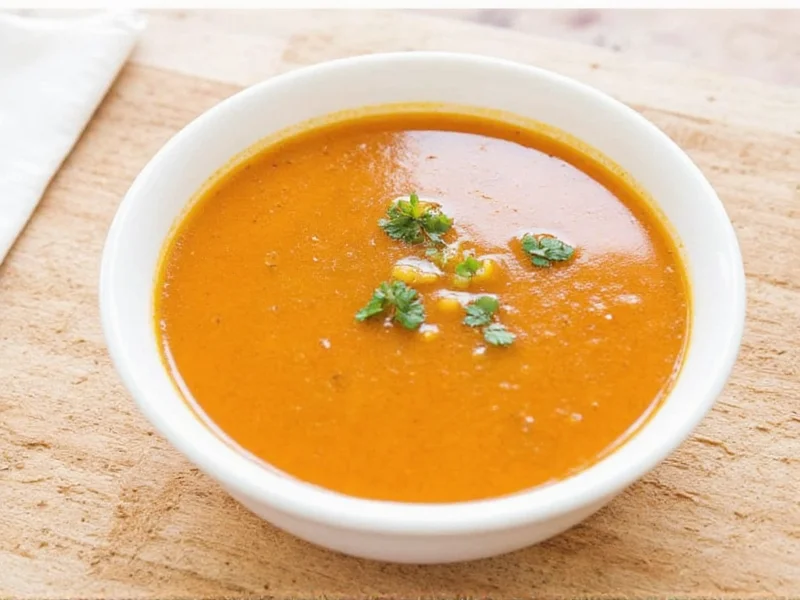Understanding proper soup storage is essential for both food safety and minimizing waste. When handled correctly, soup can be a convenient, nutritious meal option that lasts several days in your refrigerator. This guide provides science-based recommendations from food safety experts to help you determine exactly how long your soup remains safe to eat.
Factors That Determine Soup Shelf Life
The actual longevity of your soup depends on multiple variables beyond just the basic timeframe. Recognizing these factors helps you make informed decisions about when to consume or discard your soup.
Ingredients Matter Most
Soups containing perishable ingredients like dairy, seafood, or meat have shorter shelf lives than vegetable-based options. The USDA Food Safety and Inspection Service emphasizes that protein-rich soups require more careful handling due to faster bacterial growth potential.
| Soup Type | Refrigerator Shelf Life | Special Considerations |
|---|---|---|
| Vegetable soup (no dairy) | 4-5 days | Acidic ingredients like tomatoes may extend freshness slightly |
| Chicken/beef soup | 3-4 days | Remove bones before storage to prevent off-flavors |
| Cream-based soups | 2-3 days | Dairy separates more quickly; texture changes indicate spoilage |
| Seafood soups | 2 days | Highly perishable; discard if any fishy odor develops |
| Broth or stock | 4-5 days | Store without herbs for maximum freshness |
Proper Storage Techniques That Extend Freshness
How you store your soup significantly impacts its actual shelf life. Follow these evidence-based methods to maximize both safety and quality.
Cooling Soup Safely Before Refrigeration
Never place hot soup directly in your refrigerator. The FDA recommends the two-stage cooling method: first cool soup from 140°F to 70°F within 2 hours, then from 70°F to 40°F within an additional 4 hours. Use an ice bath or divide large batches into smaller containers to accelerate cooling. This rapid cooling process prevents bacterial growth during the temperature danger zone.
Container Selection and Filling Practices
Air exposure accelerates spoilage, so choose containers with tight-fitting lids that minimize headspace. Glass containers with locking lids provide the best barrier against odors and moisture loss. Fill containers leaving only 1 inch of space at the top to allow for expansion if freezing later. Always label containers with both the date prepared and use-by date.
Recognizing When Soup Has Spoiled
Trust your senses when evaluating soup safety. These clear indicators signal it's time to discard your soup:
- Visual changes: Mold growth (any visible fuzzy spots), separation that doesn't reincorporate when stirred, or unnatural cloudiness
- Smell test: Sour, rancid, or unpleasant odors (beyond the normal aroma of ingredients)
- Texture issues: Slimy consistency or unexpected thickness
- Taste warning: If it tastes off, spit it out immediately and discard the entire batch
When in doubt, throw it out. The USDA emphasizes that harmful bacteria that cause foodborne illness often don't produce noticeable changes in food appearance or smell.
Special Considerations for Vulnerable Populations
Households with infants, elderly members, pregnant women, or immunocompromised individuals should adopt stricter guidelines. For these groups, consume meat-based soups within 2-3 days and vegetable soups within 3-4 days. The CDC recommends discarding any soup stored beyond these reduced timeframes to minimize foodborne illness risks.
Extending Soup Life Through Freezing
Freezing remains the most effective method for long-term soup preservation. When properly frozen at 0°F (-18°C), most soups maintain quality for 4-6 months. Follow these best practices:
- Cool completely before freezing to prevent ice crystals
- Use freezer-safe containers with minimal headspace
- Consider freezing in portion-sized containers for convenient thawing
- Remove excess air from freezer bags to prevent freezer burn
- Thaw overnight in the refrigerator, not at room temperature
Reheating Soup Safely
Proper reheating destroys potential bacteria that may have developed during storage. Bring soup to a rolling boil for at least 3 minutes, ensuring it reaches 165°F throughout. Stir frequently for even heating, especially with cream-based varieties that may separate. Never partially reheat and then return to refrigeration, as this creates ideal conditions for bacterial growth.
Common Questions About Soup Storage
Can I eat soup that's been in the fridge for 5 days?
Most vegetable-based soups remain safe for 4-5 days when properly stored, but meat or dairy-containing soups should be consumed within 3-4 days. Always check for signs of spoilage like off odors, mold, or texture changes before consuming. When in doubt, discard soup that's been refrigerated beyond recommended timeframes.
Does reheating spoiled soup make it safe to eat?
No, reheating cannot reverse spoilage or eliminate all harmful toxins produced by bacteria. Some bacteria like Bacillus cereus produce heat-stable toxins that survive boiling temperatures. If your soup shows any signs of spoilage, discard the entire batch immediately.
How can I tell if my refrigerator is cold enough for soup storage?
Use an independent refrigerator thermometer to verify your appliance maintains 40°F (4°C) or below. Place the thermometer in a glass of water in the center of your refrigerator for 24 hours for an accurate reading. The USDA recommends checking refrigerator temperature regularly, especially during summer months when ambient temperatures affect performance.
Can I store soup in the pot I cooked it in?
Transferring soup to proper storage containers is recommended. Leaving soup in the cooking pot, especially aluminum or copper, can cause metallic flavors as acids in the soup react with the metal. Additionally, cooking pots rarely have airtight lids, exposing soup to air and refrigerator odors that accelerate spoilage.
Does adding vinegar or lemon juice extend soup's refrigerator life?
Acidic ingredients can slightly extend freshness for vegetable-based soups by creating an environment less hospitable to bacteria. However, this doesn't significantly increase the safe storage window for meat or dairy-containing soups. Always follow standard food safety guidelines regardless of added acidity.











 浙公网安备
33010002000092号
浙公网安备
33010002000092号 浙B2-20120091-4
浙B2-20120091-4